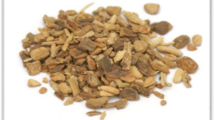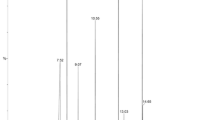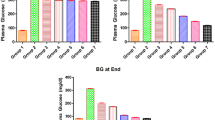Abstract
The present study was aimed to investigate the possible antidiabetic, Lipid lowering and antioxidant potential of three different extracts of Girardinia heterophylla roots on high fat diet and streptozotocin (HFD + STZ 55 mg/kg) induced diabetes in albino rats. Different extracts of Girardinia heterophylla roots (200 mg/kg b.w) were administered to diabetic rats for about 60 days. The effect of extracts on blood glucose, glycosylated haemoglobin, serum lipid profile like total cholesterol (TC), triglyceride (TG), low density lipoprotein (LDL), high density lipoprotein (HDL) and antioxidant parameters like Thiobarbituric acid reactive substances (TBARS), reduced glutathione (GSH), glutathione peroxidase (GPX), Superoxide dismutase (SOD), Catalase (CAT), Glutathione reductase (GR) were measured in control and test groups. Among the three extracts, the ethanolic extract of Girardinia heterophylla elicited significant (p < 0.05) reduction of raised blood glucose levels, lipid profiles (except HDL) and significant elevation of antioxidant levels when compared to HFD + STZ induced diabetic rats. From the results of the present study, ethanol extract of Girardinia heterophylla offers promising antidiabetic, lipid lowering and antioxidant potential that may be mainly attributed to its potent antioxidant properties.


Similar content being viewed by others
References
Aebi A (1984) Methods in enzymatic analysis, Academic Press, New York, 2: 674–84
Alberti KG, Zimmet PZ (1998) New diagnostic criteria and classification of diabetes-again? Diabet Med 15:535–536
Arvind K, Pradeep R, Deepa R, Mohan V (2002) Diabetes and coronary artery diseases. Indian J Med Res 116:163–176
Bala R, Stalin A, Ignacimuthu S (2012) Molecular docking of γ-sitosterol with some target related to diabetes. Eur J of Med Chem 47:39
Balamurugan R, Duraipandiyan V, Ignacimuthu S (2011) Antidiabetic activity of γ-sitosterol isolated from Lippia nodiflora L. in streptozotocin induced diabetic rats. Eur J of Pharmacol 667:410
Calixto JB (2005) Twenty-years of research on medicinal plants in Latin America: apersonal view. J Ethanoparmacol 100:131–134
Collins MA, Charles HY (1989) Antimicrobial activity of carnosol and ursolic acid: two anti-oxidant constituents of Rosmarius officinalis. Food Microbiol 4:311
Foster LB, Dunn RT (1973) Stable reagents for the determination of serum triglycerides by colorimetric hantzsch condensation method. Clin Chem 19:338–340
Friedwald WT, Levy RJ, Fredricken DS (1972) Estimation of LDL-C in the plasma without the use of preparative ultracentrifuge. Clin Chem 18:449
Giugliano D, Ceriello A, Paolisso G (1996) Oxidative stress and diabetic vascular complications. Diabetes Care 19:257–267
Gupta R, Sharma AK, Dobhal MP, Sharma MC, Gupta RS (2011) Antidiabetic and antioxidant potential of β-sitosterol in streptozotocin induced experimental hyperglycemia. J Diabetes 3:29
Gutteridge JMC (1995) Lipid peroxidation and antioxidant as biomarkers of tissue damage. Clin Chem 41:1819–1828
Halerstein RA (2005) Medicinal plants: Historical and cross-cultural usage patterns. Ann Epidemiol 15:686–699
Harborne JB (1984) Phytochemical methods 11 Edn. Chapman & Hall, New York, pp 4–5
Heinrich M, Barnes J, Gibbons S, and Williamson E M (2012) Fundamentals of Pharmacognosy and Phytotherapy, Churchill Livingstone, Edinburgh, UK, 2nd ed
Holman RR, Turner RC (1991) Oral agents and insulin in the treatment of NIDDM. In: Pickup J, Wiliams G (eds) Textbook of Diabetes. Blackwell, Oxford, pp 407–469
Kakkar P, Das B, Vishwanathan PN (1984) A modified spectrophotometric assay of superoxide dismutase. Ind J Biochem Biophys 21:130–132
Kandasamy M, Yeligar V, Dash DK, Sengupta P, Maiti BC, Maity TK (2006) Antidiabetic, antioxidant and anti hyperlipidemic status of heliotropium zeylanicum extract on streptozotocin induced diabetic in rats. Biol Pharma Bull 29(11):2202–2205
Kashiwada Y, Wang HK, Nagao T, Kitanaka S, Yasuda I, Fujioka T, Yamagishi T, Cosentino LM, Kozuka M, Okabe H, Ikeshiro Y, Hu CQ, Yeh E, Lee K (1998) Anti-AIDS agents, 30 Anti-HIV activity of oleanolic acid, promolic acid and structurally related triterpenoids. J Nat Prod 61(19):1090
Khare (2007) Indian medicinal plants, an illustrated dictionary, Springer 293
Kim KW (1997) Anticancer activities of plant triterpenoids, ursolic acid and oleanoid acid. J Korean Assoc Cancer Preven Metas Antitumor 2:38
Kim JD, Kang SM, Park MY (2009) Ameliorative antidiabetic activity of dangnyosoko, a Chinese herbal medicine in diabetic rats. Biotechnol Biochem 71:1527–1534
Kulkarni S (1993) Experimental pharmacology, India 168–172
Loizou S, Lekakis I, Chrousos GP, Moutsatsou P (2010) Beta-sitosterol exhibits anti-inflammatory activity in human aortic endothelial cells. Mol Nut Food Res 54:551
Loven D, Schedl H, Wilson H, Daabees TT, Stegink LD, Diekus M, Oberley L (1986) Effect of insulin and oral glutathione on glutathione levels and superoxide dismutase activities in organs of rats with streptazotocin induced diabetes. Diabetes 5:503–507
Mathé D (1995) Dyslipidemia and diabetes: animal models. Diabetes Metab 21:106–111
Nakakimura H, Mizuno K (1980) Studies on lipid peroxidation in biological system. II. Hyperlipoperoxidemia in mice induced by alloxan. Chem Pharm Bull 28:2207–2211
Netaji T, Niture AA, Ansari AA, Naik SR (2014) Anti hyperglycaemic activity of Rutin in streptozotocin- induced diabetic rats: an effect mediated through cytokines, antioxidants and lipid biomarkers. Indian J Exp Biol 52:720–727
Nisha T, Kumar S, Singh R, Singh CJ, Singh P, Varshney VK (2013) Phytochemical studies from the roots of Girardinia heterophylla Oriental. J Chem 4(8):545–550
OECD (2001) OECD Guidelines for the testing of chemicals, test no. 423: acute oral toxicity—acute toxic class method 1–5
Paglia DE, Valentine WN (1967) Studies on the quantitative and qualitative characterization of erythrocyte glutathione peroxides. J Lab Clin Med 70:158–159
Palumbo PJ (1998) Metformin: effect on cardiovascular risk factor in patients with non-insulin dependent diabetes mellitus. J Diabetes Complicat 12:110–119
Pari L, Saravanan G (2002) Antidiabetic effect of cogent db, a herbal drug in alloxan-induced diabetes mellitus. Comp Biochem Physiol C Pharmacol Toxicol Endocrinol 131:19–25
Posuwan J, Prangthip P, Leardkamolkarn V, Yamborisut U, Surasiang R, Charoensiri R (2013) Long-term supplementation of high pigmented rice bran oil (Oryza sativa L) on amelioration of oxidative stress and histological changes in streptozotocin-induced diabetic rats fed a high fat diet; Riceberry bran oil. Food Chem 138:501–508
Racker E (1955) Glutathione reductase from bakers’ yeast and beef liver. J Biol Chem 217:855–866
Rajan S, Sethuraman M (1991) Plants used in folk medicine by the Kotas of Nilgiri District, Tamil Nadu. Ancient Sci Life 10(4):223–230
Regin EG, Siby J (2014) A review of newer treatment approaches for type-2 diabetes: focusing safety and efficacy of incretin based therapy. Saudi Pharm J 22:403–410
Rukkumani R, Aruna K, Varma PS, Rajasekaran KN, Menon VP (2004) Comparative effects of curcumin and an analog of curcumin on alcohol and PUFA induced oxidative stress. J Pharm Pharm Sci 7:274–283
Sadasivam S, Manickam A (1996) Methods in biochemistry, 2nd edn. New Age International Pvt. Ltd., New Delhi
Saxena PR, Tangri KK, Bhargava KP (1966) Identification of acetylcholine, histamine, and 5-hydroxytryptamine in Girardinia heterophylla (Decne.). Can J Physiol Pharmacol 44(4):621–627
Sekar N, Kanthasamy S, William S, Subramanium S, Govindasamy S (1990) Insulinic -actions of Vanadate in diabetic rats. Pharmacol Res 22:207–217
Sener G, Sehirli AO, Gedik N, Dulger GA (2007) Rosiglitazone, a PPAR-γ ligand, protects against burn-induced oxidative injury of remote organs. Burns 33:587–593
Sheryl LM, Heberth D, Paula M, Rinaldo D, Eduardo LO, Marcelo (2005) Dietary models for inducing hypercholesterolemia in rats. Braz Arch Biol Technol 48(2):150–159
Shukla B, Visen PKS, Patnaik GK, Tripathi SC, Srimal RC, Dayal R, Dobhal PC (1992) Hepatoprotective activity in the rat of ursolic acid isolated from Eucalyptus Hybrid. Phytotherapy 6:74
Shukla R, Sharma SB, Puri D, Prabhu KM (2000) Medicinal plants for treatment of diabetes mellitus. Indian J Clin Biochem 15:169
Soon JK, Song HB, Sangku L, Hye JK, Mi KL, Yong B, Myung SC (2005) Anticholesterolemic effect of 3,4-di(OH)-phenyl propionicamides in high-cholesterol fed rats. Toxicol Appl Pharmacol 208:29–36
Subash Babu P, Prabu Seenivasan P, Ignacimuthu S (2007) Cinnamaldehyde a potential antidiabetic agent. Phytomedicine 14:15–22
Sunil C, Latha PG, Suja SR, Shine VJ, Shayamal Anju GI (2009) Effect of ethanolic extract of pisonia alba span. Leaves on blood glucose levels and histological changes in tissues of alloxan-induced diabetic rats. Int J Appl Res Nat Prod 2(2):4–11
Szyndler J, Rok P, Maciejak P, Walkowiak P, Czaonkowska AI, Sienkiewicz H (2002) Behavioral, biochemical and histological studies in a model of pilocarpine-induced spontaneous recurrent seizures. Pharmacol Biochem Behav 81:15–23
Torrico F, Cepeda M, Guerrero G, Melendez F, Blanco Z, Canelon DJ, Diaz B, Compagnone RS, Suarez AI (2007) Hypoglycemic effect of Croton cuneatus in streptozotocin-induced diabetic rats. Braz J Pharmacogn 17:166–169
Wilt TJ, Macdonald R, Ishani A (1999) Beta-sitosterol for the treatment of benign prostatic hyperplasia (a systematic review). BJU Int 83(9):976
Wrzeciono U, Malecki I, Budzianowski J, Kierylowicz H, Zaprutko L, Beimvik E, Kostepska H (1985) Nitrogenous triterpene derivatives, part 10: hemisuccunates of some derivatives of oleanolic acid and their antiulcer effects. Pharmaz 40:542
Young HS, Chung HY, Lee CK, Park KY, Yokozawa T, Oura H (1994) Ursolic acid inhibits aflatoxin B1 induced mutagenicity in a Salmonella assay system. Biol Pharmacol Bull 17:990–992
Acknowledgments
The authors are grateful to All India Council for Technical Education (AICTE), Govt. of India, New Delhi, for providing financial assistance.
Compliance with ethical standards
ᅟ
Conflict of Interest
The authors declare that they have no conflict of interest.
Informed consent
Informed consent was obtained from all individual participants included in the study.
Ethical statement
All applicable international, national, and/or institutional guidelines for the care and use of animals were followed. The experimental protocols were approved by institutional animal ethics committee (SVCP/IAEC/I-021/2013-14) and conducted according to the CPCSEA guidelines for the use and care of experimental animals, New Delhi, India.
Author information
Authors and Affiliations
Corresponding author
Rights and permissions
About this article
Cite this article
Mohanalakshmi, S., Kumar, C.K.A., Jayaraman, R. et al. Anti-diabetic, lipid lowering and antioxidant potential of Girardinia heterophylla in high fat diet and streptozotocin induced diabetic rats. Orient Pharm Exp Med 15, 287–295 (2015). https://doi.org/10.1007/s13596-015-0196-4
Received:
Accepted:
Published:
Issue Date:
DOI: https://doi.org/10.1007/s13596-015-0196-4




